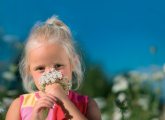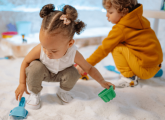Jamel Carly Campbell explains how messy play is perfect for honing children’s fine motor skills…
When I think of the development of physical skills that involve fine motor control, a scenario instantly springs to mind – parents wanting their children to be able to hold a pen or pencil correctly and write letters.
Parents or practitioners might give templates to children to aid mark making, or hold the child’s hand to guide and support them.
In some circumstances, a child may need support by using under-hand or overhand techniques, especially if they have physical mobility needs/challenges, but it’s important that we give children the space to find their preferred grasping pattern, be it full hand or tripod, to develop their hand strength and pen control.
Messy play can help to develop fine motor skills and control over one-handed tools. As educators, we are often asked, “When will my child be able to write their name? Are they falling behind?”.
I always tell parents that we should focus on hand strengthening and hand-eye coordination first. This will provide their child with the foundation skills they’ll need to hold mark-making implements and one-handed tools. It will also help with control over zips, fastenings and other actions that require fine motor manoeuvres.
I encourage all parents to allow messy play, from cornflour play to hand printing or finger painting. If indoors is too much, suggest to families that they venture outdoors – to the garden, local park or green spaces.
Messy play develops and strengthens children’s fine and gross motor skills through the repetitiveness of the different actions and manoeuvres required to manipulate or interact with the chosen activity.
Mixing mud with a stick or spoon to create pies in the mud kitchen requires a full hand grasp. Plucking flower petals and placing them in a pot requires the use of a pinching motion, which is a fine motor skill.
Using a stick to make marks in the soil requires both fine motor and gross motor movements. Even without cutting tools and mark-making implements, children can pull play dough apart and prod, twist, roll and flatten.
These fine motor and gross motor movements can help to strengthen the hands and upper body, and help children to develop the hand-eye coordination skills needed to use different grasps and manoeuvres.
The full hand grasp, also known as the palmer grasp, is the first grasp that infants use to hold different objects. As children mature, they gain more control over the objects they hold and may shift between the full hand grasp and the tripod grasp, which is the finger and thumb grasp. We see this as the ideal way to hold pencils and pens.
Play dough can be used for cutting activities with scissors, pizza cutters, pokers and dough cutters, allowing children to really explore how tools work and how to hold each tool effectively. Mud, sand, clay and cornflour can be used in the same manner.
Professor Robert Winston once said, “Humans learn new skills by repetition. Each time we complete a task, new neurological pathways are built which strengthen with time”. This is the same for the muscles and nerves around our bodies.
The repetition required for messy play helps children to explore different types of movements and develop their fine motor skills.
Edible paint: Stick a sheet of plain wallpaper to the floor. Blend a bowl of blueberries for blue, strawberries for red, spinach for green, and mix some corn flour and turmeric for yellow. Then allow children to mark make freely.
Cornflour play: Pour cornflour in a tray then lightly pour water over it a little at a time until it turns gloopy. Add different objects into the cornflour like child-friendly plastic forks, or toy animals and other small world toys.
Bubble play: Purchase a bottle of no tears, sensitive skin bubble bath. Fill a basin, tray or bucket with water then allow children to mix up the bubbles. Add straws, spoons and other toys. If you’re feeling adventurous you can add food colouring.
Jamel C Campbell is an early years educator, consultant and children’s author. He is passionate about the early years, and the importance of having a balanced, diverse and inclusive workforce, curriculum and pedagogy.
Jamel is also co-author of Building Positive Relationships in the Early Years (Routledge) Follow Jamel on @JamelCarly or Instagram: @jamel.carly

Montessori senses – Create a sensory walk
Editors picks

Sand and water table – Getting hands-on with maths
Editors picks
